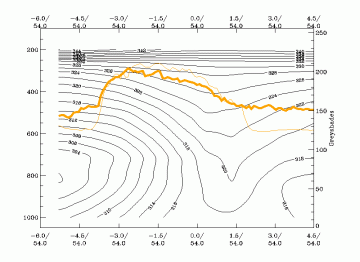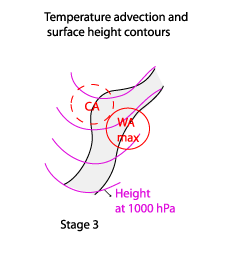Special Investigation: Can An Upper Wave Develop Into A Wave?
When applying the conceptual model of an CM Upper Wave in operational forecasting, it is important to know if an Upper Wave can develop into a "classical" Wave and even further, to an Occlusion. Out of all cases studied about 25% show some indications of development from an Upper Wave to a Wave. But only very few cases show significant development, let alone development into true cyclogenesis.
From the point of view of key parameters and vertical cross sections, only a few parameters show a complete change into a "classic" Wave. That means that Upper Waves tend to adopt single Wave - like characteristics, e.g. amplification of the Wave bulge, but are most do not completely become "classical" Waves.
In the following example, dated 16 March 2005, there is modification of an Upper Wave when seen from the CM point of view:
Cloud structure in satellite images
Satellite images show at least an amplification of the cloud bulge and a retardation of the propagation of the wave along the frontal cloud band (i.e. the Wave becomes "slower"). The character of the cloud bulge is then similar to a "classic" Wave, but there is no further development of the Wave bulge.
In the IR image for loop 16 March 2005 shown below, such a development can be seen over the North Sea, Danmark and the Baltic Sea. At the end of the loop a Wave like feature can be seen over Russia.
 Loop: 6 March 2005 16/18.00 - 17/15.00 UTC 3-hourly image loop Loop: 6 March 2005 16/18.00 - 17/15.00 UTC 3-hourly image loop
|
|
16 March 2005/18.00 UTC - Meteosat 8 IR 10.8 image
|
Though the case of 16 March 2005 shows a distinct amplification of the Wave bulge during its lifecycle, the Upper Wave is still dominated by upper relative streams. The limiting streamline between the Upper Relative Stream (u.r.s.) and the Warm Conveyor Belt (w.c.b.) is situated far in front (see schematic below).
In the IR10.8 image loop, below right, the relative streams on the 312K surface can be observed during the development phase. It can be seen that at this layer, which is situated in the middle of the troposphere, the Warm Conveyor Belt has minimal influence on the circulation over the Wave bulge during the following 18 hours. This pattern fits well with the CM of the Upper Wave. The processes described by relative streams do not support a transformation from an Upper Wave to a "classic" Wave.
Key Parameters
The most important parameters to distinguish between an Upper Wave and a Wave are the height contours at 1000 hPa and the temperature advection field at 700 hPa. By 17 March 2005 at 12.00 UTC a flat surface trough connected to the Cold Front can be seen over the cloud band. No distinct separate surface low has yet developed in the region of the Wave bulge of the Upper Wave over Estonia, although the Wave bulge has amplified significantly during the life cycle (seen in the IR10.8 loops above). A maximum of temperature advection is observed in the vicinity of the cloud bulge, but the Wave bulge itself is still under cold advection (see schematic and image below).
|
17 March 2005/12.00 UTC - Meteosat 8 IR 10.8 image; red: temperature advection 700 hPa; magenta: height contours 1000 hPa
|
|
Typical appearance in vertical cross section
Usually the parameters do not change much during the life cycle of an Upper Wave but, as mentioned before, single parameters show a tendency to develop Wave - like characteristics. If there is an amplification of an Upper Wave, the PV=1 unit, which can only be seen initially at levels higher than 500 hPa, will expand down to lower levels. In most of the cases a single maximum of PV=0.8 units develops at middle levels. This resembles the appearance of potential vorticity associated with a classic Wave, but the PV values are much less than those within a maximum of potential vorticity in a "classic" Wave.
The case of 16 March 2005 shows such a development. In the IR10.8 image loop below the vertical cross sections for each time step (6 hours) are indicated.
 Loop: 16 March 2005 16/18.00 - 17/12.00 UTC 6-hourly image loop Loop: 16 March 2005 16/18.00 - 17/12.00 UTC 6-hourly image loop
|
|
16 March 2005/18.00 UTC - Meteosat 8 IR 10.8 image; position of vertical cross section indicated
|
The sequence of cross sections (see below) displays the development of a single maximum of potential vorticity at middle levels for the same period of time as in the IR 10.8 loop above (cross sections are indicated in the IR loop above). A tear - off into a secondary maximum of potential vorticity which is typical for this type of development can be seen during the loop. The numerical values of the PV maximum at low and middle levels (about 0.8 PVU) are less than those associated with a "classic" Wave. Usually values much greater than PV = 1 unit can be observed below the bulge of a Wave.








